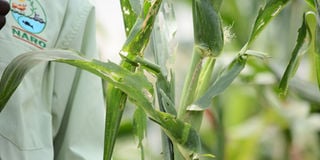Prime
Scientists develop sustainable Fall Armyworm management

Dr Otim displays a maize stalk ravaged by the Fall Armyworm. Photo | Lominda Afedraru
What you need to know:
- In Uganda, the Ministry of Agriculture advised farmers to use Rocket to spray their farms. Towards the end of last year, the incidence of the pest was reducing but it has since sprung and farmers are in a dilemma on what to do next.
Fall Armyworm (FAW) has been ravaging maize fields in Africa since 2016 with the first incidences reported in Southern Africa countries. In East Africa, it was first reported in western Kenya by farmers in March 2017 and immediately confirmed by the Kenya Plant Health Inspectorate Service and Kenya Agricultural and Livestock Research Organisation.
It immediately spread to the neighbouring countries of Uganda, Burundi, Ethiopia and Rwanda raising alarm amongst policy makers.
In Uganda, the Ministry of Agriculture advised farmers to use Rocket to spray their farms. Towards the end of last year, the incidence of the pest was reducing but it has since sprung and farmers are in a dilemma on what to do next.
Currently, more than 30 countries have identified the pest within their borders including the island countries of Cape Verde, Madagascar, São Tomé and Príncipe and the Seychelles. FAW type introduced into Africa is the haplotype originating from south Florida, USA and the Caribbean.
However, scientists at the National Crops Resources Research Institute (NaCRRI) have since had various concreted efforts in trying to devise means to control FAW.
This time the team led by Dr Michael Hilary Otim, under a Development and Promotional Sustainable Fall Armyworm project which has been ongoing since 2018 ending 2020, have done tremendous work through a project funded by the Alliance for Green Revolution in Africa (AGRA).
Dr Otim explains that the pest is capable of feeding on more than 80 different crop species, making it one of the most damaging crop pests. Some of the crops include maize, sorghum, rice, sugarcane, cabbage, groundnut, soybean, onion, cotton, pasture grasses, millets, tomato, potato and cotton.
He noted that: “The goal of the project was for scientists to contribute to enhanced sustainable control of FAW in Uganda, and other neighbouring countries that would benefit from our results. As well as evaluate additional effective, insecticides for managing FAW and to determine the yield losses associated with FAW infestation,” he notes.
How FAW behaves
The FAW moths have both a migratory habit and a more localised dispersal habit. It can migrate more than 500 km before positioning to settle in one place. When the wind pattern is right, moths can move much larger distances of 1,600 km. The pest is capable of persisting throughout the year.
The Director General of National Agricultural Research Organistaion, Ambrose Agona, explains some of the long- and short-term measures farmers in Uganda can adopt in a bid to prevent the pest from infesting their fields.
Armyworm species
There are a number of species of armyworm caterpillars, many with a distinct taste for a particular plant or vegetable. Some will eat anything green. They attack at night and hide in plants and under garden debris during the day.
They attack the crop at their larval stage sometimes moving in masses to new areas in search of food. In Uganda the attack is mostly aerial, with the gray moths usually arriving under cover of darkness to lay eggs on leaves of maize in farmer fields.
Using sex pheromone traps
Farmers have been advised to erect pheromone traps near fields to trap adult male moths. A pheromone is a chemical secreted by a female insect to attract males for mating and once the male insects are trapped in the bucket there is no more possibility of mating.
It is important to establish it in one month before planting the crop and the trap is placed next to the maize field so that the scent of the pheromone is carried across the top of the plants by the wind and they should be hanged on poles. It is replaced every
Use of natural predators
Farmers are advised to avoid using harmful pesticides or practices that would inadvertently destroy beneficial insects. Some bird species, especially soldier birds are good at consuming the fall armyworm and farmers are advised not to scare away birds seen in search of pests in their farms.
Farmers are expected to spray the field with insecticides such as Garden Dust, Monterey Garden and Rocket. They must use selective and biological pesticide containing Bacillus thuringiensis to control leaf eating caterpillars and FAW.
FAW in tropical climates completes its life cycle in 30-40 days and farmers are expected to avoid treating successive generations of the pest with the same active ingredient.
Other preventive methods
Farmers have been sensitised to use natural horticultural oil spray, an example is multipurpose neem oil spray at various stages of larvae growth.
The head of cereal research at NaCRRI, Dr Jimmy Lamo, noted that there were many donors who have been funding fall army preventive measures at the institute including AGRA.
Challenges
Dr Otim identified the challenges faced during implementation of the project as Covid-19 which reduced outreach, destruction of experiment by animals and termites, delayed report approval and disbursement, drought andflooding
Fall Armyworm strains having mutations for resistance to organophosphates and pyrethroids, among others.
Naro Deputy Director General, Agriculture Technology Promotion, Dr Sadik Kassim noted that it is important for agricultural scientists to tackle challenges farmers are faced with such as FAW. This he said therefore calls for more scientists to be trained in the area of entomology in order to tackle the challenge of pests and diseases.
Tactics
Approaches
Reviews to identify candidate insecticides.
Laboratory and field evaluations (insecticides and yield loss studies).
Training of stakeholders and developing of training materials in local languages.
The team identified 20 insecticides and evaluated seven insecticides including; (Chlobenzo, Striker, Roket, Dimethoate, Amdocs, Nomax and Tihan) for FAW control.




